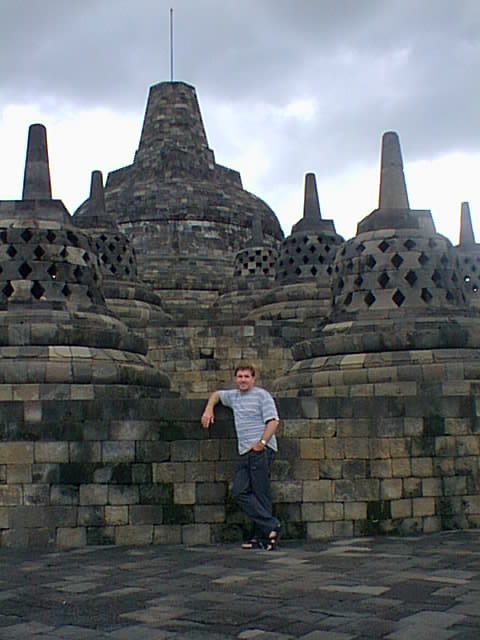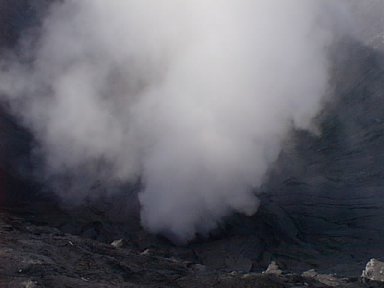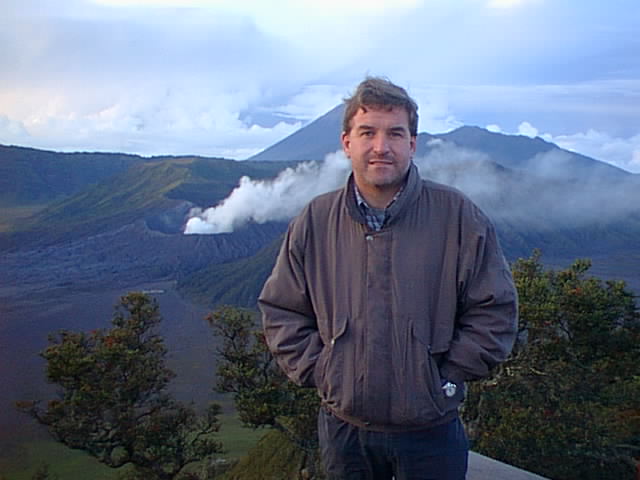
Day 1 Jakarta
We drive from the airport on a stretch of well-kept motorway, flanked with huge billboards advertising golf ranges and polo-playing holidays. There is an awful lot of food about. The roadside is stacked with bananas, yams, melon, rambutan, avocado and, of course, the famously smelly delicacy durian, which, as they say here, 'smells like him, tastes like her'.
Not far along our way this morning is evidence of the seismic instability that makes this island a farmer's and a vulcanologist's paradise. Piles of rich black soil stacked by the roadside are the remains of deposits from nearby Mount Galunggung, one of Java's thirty active volcanoes. Galunggung had its fifteen minutes of fame in 1982, when its plume of freshly-discharged volcanic ash enshrouded an over-flying 747, shutting down all four of its engines. The plane plunged, but by some miracle the pilot was able to restore enough power to enable him to land safely in Jakarta.
The violent, unpredictable energy of the volcanoes has created a Garden of Eden as well as a killing field. These plains may have seen devastation and destruction but for now the rich, intensively cultivated countryside on the road between Bandung and Ciamis is unequivocally friendly. Amphitheatres of terracing rise on both sides of a narrow valley. I count forty-eight levels on one side alone, all still worked by traditional methods. Men with long-handled rakes push the mud back and
forth to make it ready for sowing and women, wading in up to their knees, insert the carefully husbanded rice shoots. The colour and quality of the soil on these slopes is unlike anything I've seen. It's deep maroon, a rich plum-coloured satin.
One of the pleasures of Java is that so much of the island is as yet unspoiled by agribusiness. The main road remains a single carriageway and we are as likely to be held up behind a pony and trap as an over-laden banana lorry. The houses, standing amongst green fields and flower-strewn verges, are solidly built, more reminiscent of Provence than the East Indies. NearIy every one of them, however humble, sports a satellite dish.
Once into Central Java, the countryside becomes less intimate and regimented lines of spindly white rubber trees stretch away on either side of us, bowing and bending in the wind like mourners at a funeral.
Our hotel is on the Jalan Malioboro, which is named, not after a cigarette, but after the Duke of Marlborough, a name it must have received during the brief period at the start of the nineteenth century when the British ruled Java. Malioboro leads down towards the Kraton, the eighteenth-century palace of the Sultans of Yogyakarta. It is set within four square walls, each one about two-thirds of a mile in length, in which there are nine gates, symbolizing, we are told, the nine entrances to the human body. (In the bus afterwards none of us could come up with more than seven. Or eight at most. Not including bullet holes.) A sign beside the brass-studded teak doors depicts two cartoon torsos, one of which is squeezed into a lurid patterned pair of Y-fronts, while the other bulges out of a clinging pair of white shorts. Alongside both is the word 'NO'.
Having changed out of our Y-fronts, we pass through into an eclectic mix of buildings ranging from Hindu-Javanese temples, Islamic mosques, classical columned pavilions to a wrought iron and stained glass, belle-epoque, French bandstand.
DAY 4: Yogyakarta to Borobudur
It's the morning rush hour. A swirl of people on gurgling mopeds, hoods down and plastic capes flapping, head into the city like a flock of strange birds.
Out in the countryside, swelled by twelve hours of continuous downpour, rivers the colour of strong tea are running wide and fast. In the rice fields work goes on under a forest of plastic umbrellas.
Not far from Yogya there rises one of the great monuments of the world, the huge Buddhist temple of Borobudur, a massive construction of black larval stone that has stood on a low hill surrounded by rice fields and coconut groves for twelve hundred years. Rather like the Nileside temples in the sands of the Sahara, Borobudur was neglected, overgrown until the nineteenth century, when it attracted the attention of European colonists, Stamford Raffles, founder of Singapore, who once administered Java, wrote a book about the 'rediscovery' of Borobudur that captured the Western imagination and from that time on it was progressively repaired and restored. Work still goes on, supervised by UNESCO who have spent over twenty million dollars here.

The huge complex is designed as a series of five terraces which represent a mandala, a symbol of the harmony of the universe. The terraces form a path to enlightenment that runs around the temple for almost two miles. It is flanked by walls intricately and profusely decorated with stone relief carvings depicting the Buddha's own search for enlightenment.
The great black basalt mass looks dour and unpromising as we mount the first steep steps. But rich rewards for perseverance are to be found along the way. In the soft, friable rock, beautiful panels have been carved. Although there are other abstract designs, it is the scenes of everyday life which are most affecting. Human figures and facial expressions are caught with an intimacy and immediacy that is almost shockingly modern. At various points on our way intriguing notices read 'No Scratching!'. A jovial, hard-hatted UNESCO official who is checking moss deposits sees me puzzling over them. 'It does not mean no scratching of the body sir! ... No scratching of the stones.' Six hundred builders and stonemasons, he says, were required to replace two million stones during the recent nine year restoration period so they're understandably touchy about them.
On the top of Borobudur, a single solid stupa - the pointed bell-like dome common to Buddhist temples - is surrounded by concentric rings of smaller domes. Our guide explains, the location of a monument like this would not be arbitrary. It is equidistant from five volcanoes, three of them over 10,000 feet high, not only putting it at the symbolic centre of a universe but acknowledging the symbiotic relationship between man and the volcanoes from which this land was created.
DAY 5: Mount Bromo
My alarm clock sounds at 3.10 in the morning. It doesn't take much to wake me as I've been kept on the edge of consciousness by bone-numbing coldness. The surroundings are unfamiliar. A timber cabin with a no hot water.
Gradually I assemble the pieces. After yesterday's drive across into East Java, during which we avoided certain death about once an hour on a treacherous road packed with cars, fuel tankers, goats, men with grass strapped to their bicycles and coaches hurtling down the middle of the road, accelerators and horns hard down, we ended up in the foothills of the Tengger Highlands. Steep gradients and hairpins brought us up slowly but surely into cool refreshing mountain air, 7000 feet above sea level.
Cool and refreshing it may have been last night, this morning it is just bitterly cold as I delve into the bottom of my bag for every sweater I can find, all the while cursing sunrises, volcanoes, and everything that has brought me to this godforsaken place at this godforsaken time.
A cup of coffee and a bar of chocolate later, it's 3.45 and I'm sat astride a small pony heading off into the darkness. The sky is clear, there is no wind and the stars are out. A group of local guides watch their ponies anxiously as they bear us off down a stony track. We are a motley posse. Some Japanese, an Australian or two. The only thing we have in common is an inability to ride.
After half an hour the stony track levels out and I feel a little more confident astride my podgy little mount; comforted by the warmth he emits as I put my hand to his neck. We strike out across a solid, dusty plain. The first pale shades of blue and white creep into the pitch-black sky and it's like having a blindfold lifted.
At first sight we are in a stark, silent, vaguely menacing landscape, unlike anything I have ever seen. And the more the light fills the sky the stranger it becomes. We are crossing a deeply fissured surface between looming ridges of volcanic ash stretching, like giant splayed fingers, up to the top of the nearest peak. A lone cloud hovers above the peak and I catch an unmistakable smell of sulphur. We are near to our destination, Mount Bromo, active volcano. Height: 7639 feet above the sea. Latest substantial eruption: last October.
We leave our horses and climb two hundred steps to the rim of the cone. The scene behind us is biblical. A column lit by lamps and torches is crossing the dusty plain and heading towards us, occasionally vanishing from sight behind the dunes of freshly-spewed lava.
I pick my way cautiously along the narrow lip of the volcano and, when I have found a secure footing, peer down inside for the first time. Five hundred feet below me at the bottom of a great blasted bowl of earth is a black hole from which rises, slowly and steadily, a hissing plume of white steam, soft as a sigh at the moment but brooding and threatening, like a fuse attached to explosive.

This is for me a great a manifestation of the earth's natural power. Here on the edge of Mount Bromo, I'm looking at what has been blasted out. Brand new landscape, oven-fresh and still steaming. Rock so new that you could write your name in it.
I stay as long as I can, until the crowds of gabbling visitors have gone and a hazy pale-lemon sun has risen.

The weather I was so rude about early this morning is now almost perfect. The sun shines from a sky skimmed with high cirrus cloud, the air is dry and fresh, the temperature 70 degrees Fahrenheit with a gentle breeze that comes and goes.
The people in the villages we pass on the way down are mostly Hindus, pushed to the farthest end of the island during the Muslim conquest of Java in the seventeenth century. They make a precarious living in every sense of the word, growing onions, leeks, cabbages and other crops on sheer slopes that seem to defy gravity.
Well in actual fact I didn't write the above. You have probably guessed that it is for too good for me (many long words!). I found, after I'd returned, that Michael Palin had done the exact same journey across Java as part of his "Full Circle" expedition. When I bought the book I realised how similar his experience had been to mine I decided to save myself the work and copy his story into my diary. (The pictures are mine though).
Michael Palin went on to Australia after this. I went on for four days relaxing on Bali.